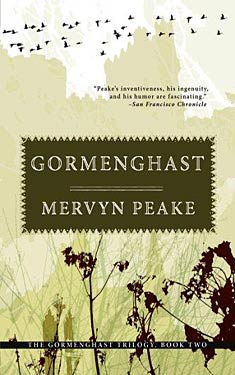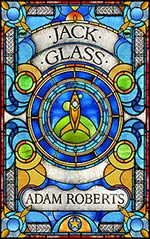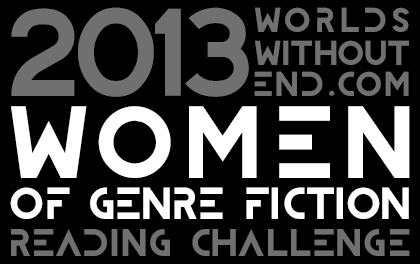Women of Genre Fiction Reading Challenge: March Review Poll and Stats
 Another month, another 114 books read! Over the month of March we saw enough great WoGF challenge reviews that we had to feature 20 of them in the blog. Here’s a reminder of what March had to offer:
Another month, another 114 books read! Over the month of March we saw enough great WoGF challenge reviews that we had to feature 20 of them in the blog. Here’s a reminder of what March had to offer:
- Miserere by Tereha Frohock – Lynn Williams (lynnsbooks)
- The Best of All Possible Worlds by Karen Lord – Steven M. Long (Stevenmlong)
- The Killing Moon by N. K Jemisin – Jack Dowden (Jdowds)
- Rusalka by C. J. Cherryh – Thom Denholm (Thomcat)
- Ironskin by Tina Connolly – Emily Sandoval (ersandoval)
- The Night Circus by Erin Morgenstern – Alexandra P. (everythinginstatic)
- The Drowning Girl by Caitlin R. Kiernan – Daniel Roy (Triseult)
- Kushiel’s Dart by Jacqueline Carey – Maylin Tan (dihenydd)
- Boneshaker by Cherie Priest – Matt W. (Mattastrophic)
- His Majesty’s Dragon by Naomi Novik – Nathan Barnhart (Skynjay)
- Frankenstein by Mary Shelley – Nerlinga (Zoori)
- The Handmaid’s Tale by Margaret Atwood – Nadine Gemeinböck (Linguana)
- Ammonite by Nicola Griffith – Jonathan Thornton (thrak)
- The Heritage of Hastur by Marion Zimmer Bradley – Brett Ellis (Brett72)
- Those Who Hunt the Night by Barbara Hambly – Carrie Naughton (Bookkeeper)
- Ironskin by Tina Connolly – Barry F. (bazhsw)
- Souless by Gail Carriger – Christine Bellerive (cmbellerive)
- Mechanique by Genevieve Valentine – Leslie Darnell (Leslie D)
- The Snow Queen by Joan D. Vinge – Allie McCarn (Allie)
- The Summoning by Kelley Armstrong – Barbara Evers (Bevers)
The poll is now open, so please review this month’s entries and vote for your favorite! As always, there are three prizes up for grabs. The poll will remain open until April 17.
Last but not least, Rhonda Knight has once again compiled stats for the last month:
Genre
- General Fantasy – 102
- Soft SF – 53
- Contemporary Fantasy – 46
- Alt. History/Time Travel – 38
- Horror – 30
- Hard SF – 17
- Steampunk – 16
- Military SF – 15
- Urban Fantasy – 12
- Pulp/Space Opera – 9
- Other – 9
- Cyberpunk – 7
Authors
- Connie Willis – 15
- Margaret Atwood – 9
- Jo Walton – 8
- Kage Baker – 7
- Octavia Butler – 7
Books
Forays into Fantasy: Mervyn Peake’s Gormenghast
Scott Lazerus is a Professor of Economics at Western State Colorado University in Gunnison, Colorado, and has been a science fiction fan since the 1970s. The Forays into Fantasy series is an exploration of the various threads of fantastic literature that have led to the wide variety of fantasy found today, from the perspective of an SF fan newly exploring the fantasy landscape. FiF will examine some of the most interesting landmark books of the past, along with a few of today’s most acclaimed fantasies, in an attempt to understand the connections between fantasy’s origins, its touchstones, and its many strands of influence.
 Gormenghast was released in 1950, the same year as The Lion, the Witch, and the Wardrobe. The Lord of the Rings would soon follow. These latter two works may be seen as the defining fantasies of the second half of the twentieth century, altering the landscape of the field, popularizing the secondary world fantasy and setting the stage for the advent of fantasy as a commercial genre in the late 1960s. As well as developing an enduring popularity that continues into the present, these books (especially, or course, The Lord of the Rings) have been more influential on fantasy literature than anything since. And yet, though it is not read as widely as these two contemporaries, Mervyn Peake’s Gormenghast novels, conceived in that same post-war period in England, seem to me to be just as important. Unlike Tolkien and Lewis, Peake has not inspired hordes of imitators or greatly influenced the direction of commercial fantasy. The influence of Mervyn Peake could not be based on imitating the plot structure or external trappings of his creation—the books are too idiosyncratic for that to be a temptation. Rather, the strand of Peake’s influence can be seen in those writers of modern fantasy who have rejected the commercial allure of Tolkien-like epic fantasy in order to pursue their own personal fantastic visions, and those for whom character, theme, and style are at least as important as plot and exterior world-building.
Gormenghast was released in 1950, the same year as The Lion, the Witch, and the Wardrobe. The Lord of the Rings would soon follow. These latter two works may be seen as the defining fantasies of the second half of the twentieth century, altering the landscape of the field, popularizing the secondary world fantasy and setting the stage for the advent of fantasy as a commercial genre in the late 1960s. As well as developing an enduring popularity that continues into the present, these books (especially, or course, The Lord of the Rings) have been more influential on fantasy literature than anything since. And yet, though it is not read as widely as these two contemporaries, Mervyn Peake’s Gormenghast novels, conceived in that same post-war period in England, seem to me to be just as important. Unlike Tolkien and Lewis, Peake has not inspired hordes of imitators or greatly influenced the direction of commercial fantasy. The influence of Mervyn Peake could not be based on imitating the plot structure or external trappings of his creation—the books are too idiosyncratic for that to be a temptation. Rather, the strand of Peake’s influence can be seen in those writers of modern fantasy who have rejected the commercial allure of Tolkien-like epic fantasy in order to pursue their own personal fantastic visions, and those for whom character, theme, and style are at least as important as plot and exterior world-building.
This is not to say that world-building is not important in Peake’s works, but it is not of the sort that epic fantasy fans will be looking for. The inhabitants of Gormenghast can only be defined in relation to the environment their forebears created for them, and this environment—Gormenghast castle and it’s immediate natural surroundings—is described in such visual terms that the setting is evoked in a way rarely achieved, and this setting is arguably more interesting than any individual character. But this world-building is focused interiorly on the isolated castle. There’s no need for a map to track the characters’ progress, and the outside world is never described in the first two Gormenghast novels. This aspect adds to the strangeness and dislocation created by Peake’s writing, since the reader knows nothing of the larger world in which Gormenghast is situated. The result is a strange combination of dislocation and concreteness. We do not know where or when Gormenghast exists, yet it comes to seem entirely real on its own terms. The concreteness of the castle setting is further enhanced by the fact that Gormenghast seemingly has not changed for centuries, possibly millennia (aside from a slow deterioration), and it is this fact that creates the conflict that first become apparent in the first Gormenghast novel, Titus Groan (1946, see previous post), and comes to a head in the second, Gormenghast (1950).
The “Sliders” Movie You’ve Been Waiting For
Part of Kickstart or Die’s April Fools campaign (some NSFW language):
They have a few more movie “projects” in the works, including Wings, Dinosaurs, Family Matters, and Darkwing Duck.
2012 British Science Fiction Association Award Winners Announced
 The winners of the 2012 British Science Fiction Association Award were announced last night at Eastercon 64. The winners are:
The winners of the 2012 British Science Fiction Association Award were announced last night at Eastercon 64. The winners are:
- Novel: Jack Glass – Adam Roberts (Gollancz)
- Short Fiction: “Adrift on the Sea of Rains”, Ian Sales (Whippleshield Books)
- Artwork: Blacksheep for the cover of Adam Roberts’ Jack Glass (Gollancz)
- Non-Fiction: The World SF Blog, Chief Editor Lavie Tidhar
Congratulations to the winners and nominees!
Thanks to Locus Online for the report.
Peter Jackson Teases The Hobbit 2
Not a lot of info in this one, but Stephen Colbert and Billy Boyd both make appearances, and Jackson teases some Mirkwood-related artwork for the second film.
If you haven’t seen it yet, be sure to check out the first in my series examining the history of film adaptations of The Hobbit in “Hell is Adaptations: The Hobbit!”



















 Full Details
Full Details


